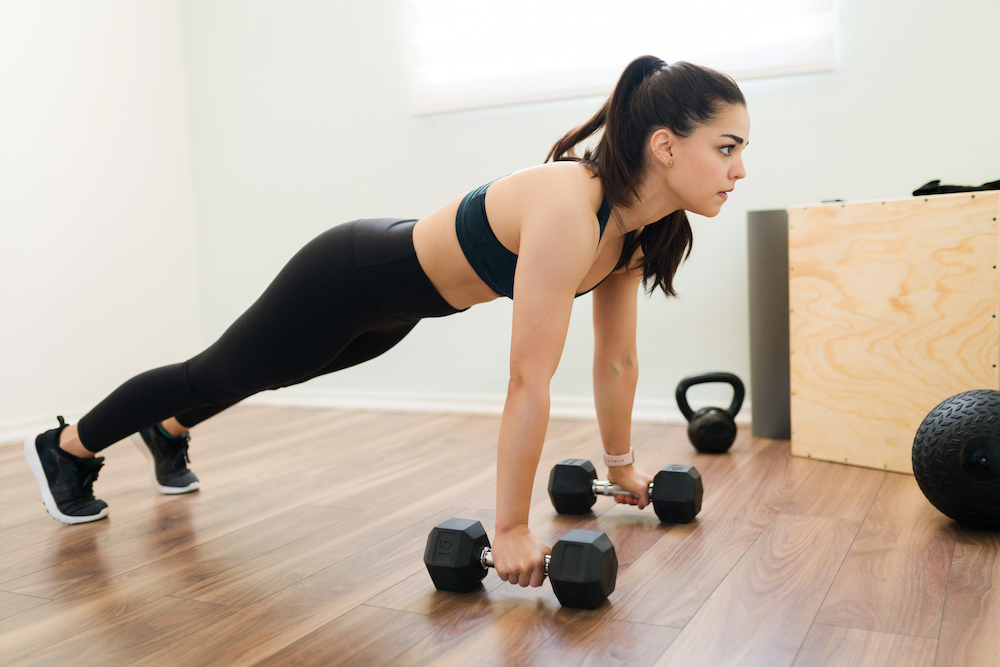A strength workout, also known as resistance training or weightlifting, involves exercises that target and challenge your muscles. It focuses on building muscle strength, increasing muscle tone, and enhancing overall physical performance. By lifting weights or using resistance equipment, you can improve muscle definition, boost metabolism, promote weight management, and strengthen bones and joints. Additionally, strength training enhances athletic performance, increases energy levels, improves mood, and contributes to better cardiovascular health. It’s a great way to improve both your physical and mental well-being, leading to increased confidence and self-esteem.

The benefits of a strength workout

Strength training, offers numerous benefits for both your physical health and overall well-being. Whether you’re a seasoned athlete or a fitness beginner, incorporating strength workouts into your routine can have a positive impact on various aspects of your life. In this response, We will highlight some of the key advantages of engaging in strength training.
Increased muscle strength and tone
Strength training is designed to challenge your muscles and promote their growth and development. Regularly lifting weights or using resistance equipment can lead to significant increases in muscle strength and definition. Stronger muscles not only enhance your physical performance in various activities but also contribute to improved posture, balance, and stability.
Weight management and increased metabolism
Strength training plays a crucial role in weight management and fat loss. While cardiovascular exercise helps burn calories during the workout, strength workouts have a longer-lasting effect on your metabolism. As you build lean muscle mass, your body requires more energy to maintain and repair those muscles, resulting in a higher resting metabolic rate. This increased metabolism can help you burn more calories throughout the day, even when you’re at rest.
Enhanced bone health and reduced risk of osteoporosis
Engaging in regular strength training can positively impact your bone health, especially as you age. Weight-bearing exercises stimulate the production of new bone tissue and help prevent the loss of bone density. This is particularly beneficial for women, as they are more prone to developing osteoporosis later in life. By strengthening your bones, you can reduce the risk of fractures and maintain better overall skeletal health.
Improved joint function and flexibility
Strength training exercises target the muscles surrounding your joints, which helps improve their stability and function. Stronger muscles provide better support to your joints, reducing the risk of injuries and conditions such as arthritis. Additionally, through a full range of motion exercises, strength training can enhance your flexibility and overall mobility, making daily activities easier and more comfortable.
Enhanced athletic performance
Whether you’re a professional athlete or simply enjoy participating in recreational sports, strength training can significantly boost your performance. By increasing your muscle strength, power, and endurance, you can run faster, jump higher, throw farther, and perform better in various sports-specific movements. Strength training also helps prevent injuries by strengthening the muscles, tendons, and ligaments, allowing you to train harder and compete at a higher level.
Increased energy levels and improved mood
Strength workouts have a positive impact on your mental well-being. Engaging in physical activity stimulates the release of endorphins, the feel-good hormones that promote a sense of happiness and reduce stress and anxiety. Regular strength training sessions can help alleviate symptoms of depression, boost your energy levels, and improve your overall mood and mental clarity.
Better cardiovascular health
While strength training is primarily focused on building muscle, it also offers cardiovascular benefits. Compound exercises, such as squats, deadlifts, and bench presses, elevate your heart rate and promote cardiovascular endurance. By incorporating elements of cardiovascular training into your strength workouts, you can improve your heart health, lower blood pressure, and reduce the risk of heart disease.
Increased insulin sensitivity
Strength training has been shown to improve insulin sensitivity, which is crucial for preventing and managing type 2 diabetes. By increasing muscle mass and reducing body fat, strength workouts help regulate blood sugar levels and improve the body’s ability to utilize glucose effectively. This can be particularly beneficial for individuals at risk of diabetes or those already diagnosed with the condition.
Boosted confidence and self-esteem
Engaging in strength training and witnessing improvements in your physical strength and appearance can have a significant impact on your self-confidence and self-esteem. Achieving fitness goals, such as lifting heavier weights or achieving a new personal record, provides a sense of accomplishment and empowerment
Strength workout routine
Here’s an example of a strength workout routine that targets major muscle groups. You can easily perform these exercises at home. The only equipment you need is a set of dumbbells. If you don’t have dumbbells, you can choose to fill two bottles with water to make them heavier. Of course, you don’t have to use weights if you find it challenging enough. During these exercises you are also focused on your core. It is really important to tighten your core during the exercises.
Your NUMBER ONE fitness app available on:

- Push-ups: Assume a plank position with your hands slightly wider than shoulder-width apart. Lower your chest towards the floor by bending your elbows, then push back up to the starting position. Modify the exercise by performing it on your knees if needed. Complete 3 sets of 10-15 reps.
- Dumbbell lunges: Hold a dumbbell in each hand and step forward with one leg, lowering your body until both knees are at 90-degree angles. Push back up to the starting position and repeat on the opposite leg. Do 3 sets of 10-12 reps per leg.
- Dumbbell shoulder press: Stand with a dumbbell in each hand at shoulder height, palms facing forward. Press the weights overhead until your arms are fully extended, then slowly lower them back down. Perform 3 sets of 8-10 reps.
- Glute bridges: Lie on your back with your knees bent and your feet flat on the floor, hip-width apart. Engage your core and squeeze your glutes as you lift your hips off the ground until your body forms a straight line from your knees to your shoulders.Hold the position for a second, then slowly lower your hips back down. Aim for 3 sets of 12-15 repetitions.
- Bent-over rows: Hold a dumbbell in each hand, hinge forward at the hips, and slightly bend your knees. With your palms facing inward, pull the dumbbells up towards your chest, squeezing your shoulder blades together. Complete 3 sets of 10-12 reps.
- Plank: Get into a forearm plank position with your elbows directly under your shoulders and your body in a straight line from head to toe. Hold this position for 30-60 seconds, focusing on engaging your core muscles.
- Squat: Stand with your feet shoulder-width apart, toes slightly turned out, lower your body by bending your knees and pushing your hips back as if you’re sitting back into a chair. Keep your chest up and your weight on your heels. Push through your heels to stand back up to the starting position. Aim for 3 sets of 12-15 repetitions.
- Lunge: Stand with your feet hip-width apart, Take a step forward with your right foot, lowering your body until both knees are bent at a 90-degree angle. Keep your front knee directly above your ankle and your back knee hovering just above the floor. Push through your front heel to return to the starting position and repeat on the other leg. Aim for 3 sets of 10-12 lunges on each leg.
Remember to warm up before starting the workout and cool down/stretch afterwards. Adjust the weights and repetitions based on your fitness level and gradually increase the intensity as you progress. It’s always a good idea to consult with a fitness professional before starting any new exercise program.
Nutrition is important
When engaging in strength training, proper nutrition plays a crucial role in supporting your muscle growth, performance, and recovery. Fueling your body with the right foods can optimize your workouts and help you achieve your fitness goals. Here’s an explanation of the key aspects of nutrition for strength training, along with food recommendations:
Sufficient protein intake
Protein is the building block of muscles and is essential for muscle repair and growth. Aim to consume an adequate amount of high-quality protein sources with each meal. Good options include lean meats (such as chicken, turkey, and fish), eggs, dairy products (like Greek yogurt and cottage cheese), legumes, tofu, and plant-based protein powders.


Carbohydrates for energy
Carbohydrates are the primary fuel source for physical activity, including strength training. They provide the energy needed to power through intense workouts. Focus on complex carbohydrates, such as whole grains (oats, brown rice, quinoa), fruits, vegetables, and starchy vegetables (sweet potatoes, corn, peas). These provide sustained energy and essential nutrients.
Healthy fats
Incorporating healthy fats into your diet is important for hormone production, joint health, and overall well-being. Include sources like avocados, nuts and seeds, olive oil, coconut oil, fatty fish (salmon, mackerel), and nut butter in moderation.


Hydration
Proper hydration is crucial for optimal performance and recovery. Drink an adequate amount of water throughout the day, especially before, during, and after your workouts. For longer and intense training sessions, consider adding electrolyte-rich drinks or sports beverages to replenish lost minerals.
Pre-workout nutrition
Consuming a balanced meal or snack before your strength workout can provide the necessary energy and nutrients for optimal performance. Aim for a combination of carbohydrates and protein. Examples include a banana with a tablespoon of peanut butter, a Greek yogurt with berries, or a turkey and vegetable wrap.


Post-workout nutrition
After your strength training session, prioritize post-workout nutrition to support muscle recovery and growth. Consume a meal or snack rich in protein and carbohydrates within the first hour after your workout. This helps replenish glycogen stores and promotes muscle repair. Good options include a protein shake with fruit, grilled chicken with quinoa and vegetables, or a smoothie with Greek yogurt and oats.
You need to know this about a strength workout!
A strength workout is a form of exercise that focuses on building muscular strength and endurance. It involves performing exercises that target specific muscle groups to increase their size, power, and overall function. Strength training is beneficial for people of all fitness levels, from beginners to advanced athletes, as it provides numerous health and fitness benefits.
The primary goal of a strength workout is to challenge the muscles by using resistance. This resistance can come from various sources, such as free weights (dumbbells, barbells), weight machines, resistance bands, or even bodyweight exercises. By progressively overloading the muscles over time, strength training helps to stimulate muscle growth, improve bone density, enhance joint stability, and increase overall physical performance.
Strength workouts typically consist of exercises that target different muscle groups in the body. Common exercises include squats, deadlifts, bench presses, shoulder presses, rows, lunges, and planks. These exercises can be performed using different sets and repetitions, depending on your fitness level and goals. Beginners usually start with lighter weights and higher repetitions to focus on proper form and technique.
To see progress and maximize the benefits of a strength workout, consistency is key. Aim to incorporate strength training exercises into your fitness routine at least 2-3 times per week. It’s also important to allow for adequate rest and recovery between workouts to allow the muscles to repair and grow stronger.
Remember to start with a warm-up to increase blood flow and prepare the muscles for exercise. After the workout, cool down with stretches to improve flexibility and prevent muscle soreness. If you’re new to strength training, it’s advisable to seek guidance from a qualified fitness professional to ensure proper form and to create a program tailored to your specific needs and goals.
Always listen to your body and progress at a pace that feels comfortable and safe for you. As you become stronger, you can gradually increase the intensity of your workouts by adding more resistance, increasing weights, or trying more challenging variations of the exercises.
Fit at Home
Would you like to work on your strength with the right home workout? At Fit at Home, we have the Dumbbell & Fit workout. Together with your personal trainer, Taylor McCormack, you will work on strengthening your body in 30 minutes. During this workout, all you need is a set of dumbbells. You won’t just be training your arms, but your entire body! And the best thing is that you can easily do your workouts on demand in front of your TV whenever it suits you!

We love to make you move!
Build muscle with these workouts
Strength training is an excellent way to build muscle, increase metabolism, and improve overall physical performance. Here are some home workouts you can do for strength:
- Bodyweight exercises:
- Push-ups: Target your chest, shoulders, and triceps.
- Squats: Work your quadriceps, hamstrings, and glutes.
- Lunges: Strengthen your legs and improve balance.
- Planks: Engage your core and work on stability.
- Dips (using sturdy chairs or parallel bars): Focus on your triceps and shoulders.
- Glute bridges: Activate your glutes and lower back muscles.
- Resistance bands:
- Banded rows: Work your back and arms by attaching the band to a fixed point and pulling it towards you.
- Banded chest press: Mimic a bench press by anchoring the band and pushing it away from your chest.
- Banded leg press: Place the band around your legs and perform a squatting motion against the resistance.
- Banded bicep curls: Hold the band and curl your arms, targeting your biceps.
- Dumbbell or kettlebell exercises:
- Goblet squats: Hold a dumbbell or kettlebell close to your chest while squatting.
- Bent-over rows: Strengthen your back and arms by rowing the weight towards your chest.
- Shoulder press: Push the dumbbells or kettlebells overhead, targeting your shoulder muscles.
- Deadlifts: Hinge at the hips to lift the weights off the ground, working your lower back and legs.
- Step-ups:
- Use a sturdy chair or step, and step up and down with one leg at a time to target your legs and glutes.
- Wall sits:
- Slide your back down a wall until your thighs are parallel to the ground, and hold the position to work your quadriceps.
- Calf raises:
- Stand on a step or elevated surface and raise your heels to target your calf muscles.
- Yoga and Pilates:
- These practices can also help build strength, especially in your core, while improving flexibility and balance.
Remember to warm up before starting your strength workout and cool down afterward. Start with lighter weights or easier variations of exercises if you’re a beginner, and gradually increase the intensity as you get more comfortable. Aim for a balanced workout routine that targets all major muscle groups.